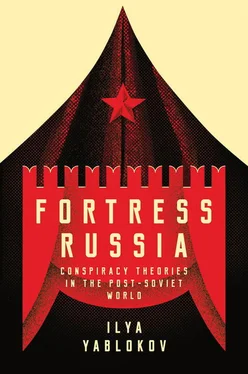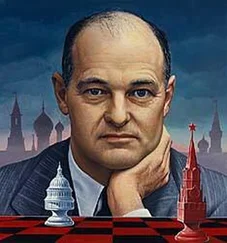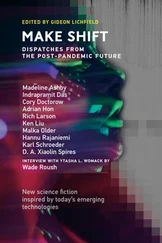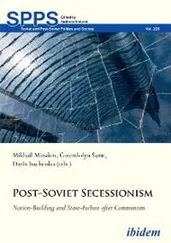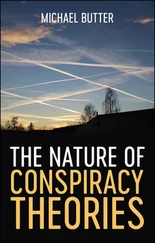Consequently, Putin was gradually developing some exceptional features and becoming a unique political figure in post-Soviet Russia. He was expected, among other things, to help unite the various social and ethnic groups in Russian society into one nation. At its meeting in May 2007, the United Russia Party voted in favour of the so-called Plan Putina ( Putin’s plan ), a set of vague ideas about socio-economic and political projects scheduled for realization in the years following the 2007–8 elections (Orlov, 2007). This initiative was mainly used to demonstrate the continuity of the regime’s policies and to emphasize the stability in Russia’s domestic policies, which was perceived as one of Putin’s main achievements. Apart from socio-economic projects, the most important part of the plan was ‘the strengthening of Russian sovereignty’, defined as Russia’s right to independently determine the direction of its political development. The leaders of United Russia stressed the uniqueness of ‘Russian civilization’ and emphasized Russia’s independence from the West. One of the party leaders at that time, Andrei Vorob’ev, stated that Putin’s plan did not signal an end to Russia’s commitment to democracy; however, ‘democracy in Russia is the power of the Russian people ’ [emphasis added – I. Y.]. Thus, Vorob’ev implicitly referred to the wave of ‘colour revolutions’, which were now said to be organized by Washington to impose on Russia a peculiarly ‘Western’ type of democracy which was alien to its own political traditions (Vorob’ev, 2007). In this context, the figure of Putin was used to demonstrate the will of ‘the people’ to democratically choose the country’s leader regardless of the will of the ‘Other’, the United States.
While high-ranking politicians only vaguely hinted at the possible threat of external invasion, pro-Putin intellectuals had more opportunities to express conspiratorial ideas in public. For instance, Dugin’s rather Manichean interpretation of Putin’s plan reduced it to the traditional opposition of Russia to the West and the latter’s purported attempts to destroy Russia in the 1990s with the help of corrupt and treacherous domestic elites:
Putin’s personal achievement was the fact that he did not listen to political elites, who had an anti-national orientation…. He did not listen to various foundations that led him to the West, pushed him towards ultra-liberalism, towards Russophobia, towards his own suicide, [as well as the destruction of] his course, the country, the nation. He did not listen to these elites, but listened to the voice of history, the voice of the people, and the voice of geopolitics. (Dugin, 2012, p. 26)
This interpretation of Putin’s plan reflects the main conspiratorial notion which was widely used in the 2007–8 campaign: a general threat to the political order coming from the West. The threat was embodied in the ‘treacherous’ activities of NGOs and the irresponsible actions of political elites in the 1990s. These elites bore the main responsibility for the collapse of the Soviet Union and the subsequent economic disorder. Putin’s plan did not contain any real political measures, but, through actions which were largely performative, it served to divide society into two groups, the loyal majority and a subversive minority. The original descriptions of the threat were vague, but they were later elaborated on by high-ranking politicians.
For instance, Boris Gryzlov, United Russia ’s chairman, claimed (2007) that without Putin, Russia would be open to plunder: ‘Contemporary Russia is Putin. “Russia without Putin” is a Russia without governance, a Russia without will. It is a Russia which could be dismembered and which could be used in whatever way. Russia up for grabs ( Rossiia kak dobycha )’. Gryzlov’s text represented a mixture of alarmist ideas about a permanent threat from internal and external enemies, and assurances that the political establishment was able to resist any sort of intrusion into domestic politics. It appealed to negative public attitudes about NATO, which at the time was seen as Russia’s rival and potential menace (Levada-tsentr, 2009). Gryzlov also mentioned the threat of the ‘colour revolutions’ and linked this to the activities of Russian NGOs. Russia was presented as a large, ‘sovereign’ community of Russian citizens led by Putin, whose actions were aimed at ensuring the prosperity and greatness of the state and its people. ‘It is time to remind ourselves: we are Russia. The scenario in which “public” organizations operating in the country are pumped with money to destabilize the situation will not take place here. The right of Russian citizens to shape their country’s destiny is not for sale’ (Gryzlov, 2007).
On 2 October 2007, at the United Russia party congress, Putin became the official leader of the party, which allowed pro-Kremlin speakers to claim that the parliamentary elections were in effect a referendum on Putin’s policies (Mashkarin, 2007). The positioning of Putin at the head of the party served to create the impression that Russia, as a whole, supported both him and his party. Those who did not support them, or held different political views, were either non-patriots or outright enemies. In this discourse, Putin, as leader of the party, not only represented ‘Russia’, but his policies and actions reflected the aspirations of ordinary citizens. Thus, he was now depicted as the spokesperson of the ‘people’, set against a minority of political opponents who represented the West. This image was further promoted by means of a media campaign which involved ordinary people. The Kremlin-aligned media claimed that these people were concerned about Putin’s political future, and were calling on the president to remain in a leadership position (Vasil’ev, 2007).
Another initiative was to attract voters with no specific political sympathies by means of a campaign entitled V podderzhku Putina ( In Putin’s support ). Its initiators claimed that 70 per cent of the Russian population could be mobilized to support Putin and that most Russians would join forces with the purpose of ‘helping Putin to work for the benefit of the Russian people’ (Bagdasarian, 2007). In the speeches of the campaign’s activists, Putin was placed in opposition to disloyal politicians, who had betrayed the country after the demise of the Soviet Union. This viewpoint was endorsed by the concept of the tumultuous ’90s ( likhie devianostye ), the time of economic and political chaos, which could only have happened with the connivance of irresponsible politicians who cooperated with the West and ultimately took the Russian people to the brink of starvation. In the words of spin doctors, intellectuals and journalists, Putin’s policies were aimed solely at ensuring stable lives for ordinary people after the chaos of the 1990s. This propaganda transformed Putin into the country’s saviour and ‘the people’s leader’.
During the first rally of the V Podderzhku Putina campaign, Vladimir Voronin, the representative of a Cossack movement, who made it clear that he did not endorse any of the political parties, expressed concern about the possible return of the instability of the 1990s:
Our logic – the logic of non-partisans and people detached from power – is simple: on 2 December 2007 we do not want to wake up in a different country, where governments change like in a film…. We do not want a power vacuum like in the 1990s. We want the preservation of stability and continuity of government, and we can only see Putin as its guarantor. (Emel’ianenko, 2007)
Reference to the recent traumatic experience of the 1990s became a pivotal element in the electoral rhetoric of the 2007–8 campaign. Every spokesperson stressed that a stable future was not yet guaranteed, meaning that the return of instability was still possible. Hence, the division was made still sharper between ‘the people’, who wanted the continutation of the stability and relative prosperity which Putin had provided in the last eight years, and the internal ‘Other’, a troublesome minority who were trying to return to power and would bring chaos in their wake.
Читать дальше
Конец ознакомительного отрывка
Купить книгу
